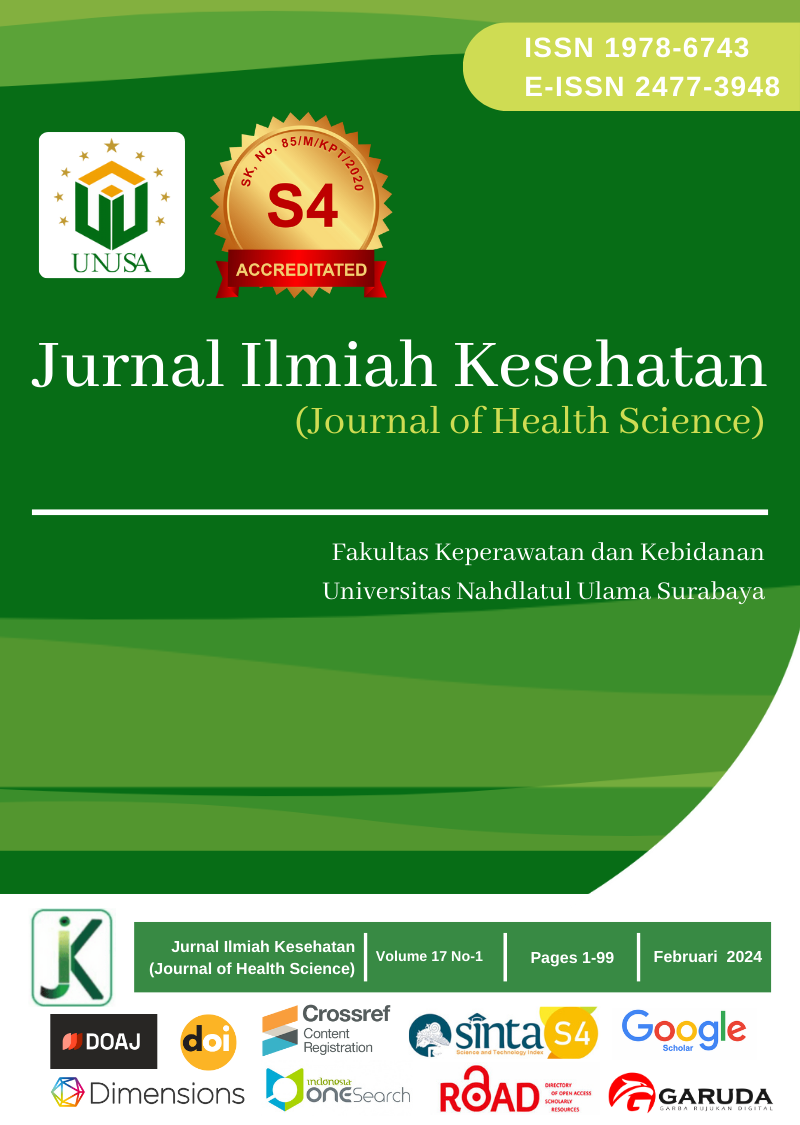Application of the Health Belief Model to Compliance with the Use of Personal Protective Equipment by Laundry Staff: A Systematic Literature Review
Main Article Content
Abstract
Personal protective equipment is essential to safeguard workers from potential hazards in the workplace, including chemicals, dust, heat, or germs. The proper use of personal protective equipment can prevent or reduce injuries and illnesses at work. The goal of this literature review is to explore research on the utilization of personal protective equipment by hospital laundry workers based on the health belief model. The systematic literature review is the chosen method for conducting this study. It is a scientific approach employed to analyze, assess, synthesize, and critique research findings on specific themes or issues. To enhance compliance with personal protective equipment among laundry personnel, it is crucial to elevate knowledge and awareness, address unfavorable attitudes or perceptions, provide resources and comfort, implement adequate supervision and procedures, and foster a supportive organizational culture. Healthcare organizations can promote adherence to personal protective equipment guidelines among laundry staff by offering instruction and training, facilitating communication and awareness, providing administrative support, enforcing oversight, setting positive role models, continuously evaluating, and improving procedures, engaging employees, and ensuring ongoing support and resources.
Downloads
Article Details
Copyright (c) 2024 Irvan Maulana, Eko Winarti, Norfidah Mohamad

This work is licensed under a Creative Commons Attribution-ShareAlike 4.0 International License.
References
Anggraeni, S. et al. (2021) ‘Faktor Yang Melatarbelakangi Ketidakpatuhan Penggunaan Alat Pelindung
Diri Lengkap Pada Petugas Laundry Di RSUD Idaman Kota Banjarbaru Tahun 2021’. Available
at: http://eprints.uniska-bjm.ac.id/8634/ (Accessed: 31 May 2023).
Artono, A. (2020) ‘Hubungan Persepsi Keselamatan Dengan Kepatuhan Penggunaan Alat Pelindung Diri
(Pendekatan Teori Health Belief Model) Pada Perawat Rumah Sakit Umum’, Jurnal Imejing
Diagnostik, 8, pp. 65–74. Available at: https://repository.unair.ac.id/95031/ (Accessed: 24 May
.
Berhimpong, M.J.A., Rattu, A.J.M. and Pertiwi, J.M. (2020) ‘Analisis Implementasi Aktivitas Fisik
Berdasarkan Health Belief Model oleh Tenaga Kesehatan di Puskesmas’, Journal of Public
Health and Community Medicine, 1(4), pp. 54–62.
Chotimah, C.C., Haryadi, H. and Roestijawati, N. (2019) ‘Pengaruh Pengetahuan, Motivasi Dan Persepsi
Risiko Terhadap Perilaku Penggunaan Alat Pelindung Diri Dasar Yang Dimoderasi Faktor
Pengawasan Pada Civitas Hospitalia RSGMP UNSOED’, Jurnal Ekonomi, Bisnis, dan Akuntansi,
(3). Available at: https://doi.org/10.32424/jeba.v21i3.1367. DOI: https://doi.org/10.32424/jeba.v21i3.1367
Dickson, E.F.G. (2012) Personal Protective Equipment For Chemical, Biological, And Radiological DOI: https://doi.org/10.1002/9781118422991
Hazards - Design, Evaluation, and Selection. Kingston, Ontario, Canada: John Wiley & Sons,
Inc., Hoboken, New Jersey.
Environmental Health and Safety (2018) ‘Personal Protective Equipment Manual Equipment (PPE)’, pp.
–36.
Istigfari, L.D. (2022) ‘Kepatuhan Penggunaan Alat Pelindung Diri pada Petugas Kesehatan di Rumah DOI: https://doi.org/10.14710/hnhs.5.1.2022.111-124
Sakit melalui Pengembangan Metode Human Factor Design: Kajian Literatur’,
ejournal2.undip.ac.id, 5(1), pp. 111–124. Available at:
https://ejournal2.undip.ac.id/index.php/hnhs/article/download/14908/7622 (Accessed: 31 May
.
Istigfari, L.D. et al. (2022) ‘Kepatuhan Penggunaan Alat Pelindung Diri pada Petugas Kesehatan di
Rumah Sakit melalui Pengembangan Metode Human Factor Design: Kajian Literatur’, Holistic
Nursing and Health Science, 5(1), pp. 111–124. Available at:
https://ejournal2.undip.ac.id/index.php/hnhs/article/download/14908/7622 (Accessed: 31 May
.
Karen Glanz, Barbara K. Rimer, K. Viswanath, Karen Glanz, Barbara K. Rimer, K.V. (2015) Health Behavior Theory, Research, and Practice 5th edition. 5th editio. Available at:
https://www.perlego.com/book/996608/health-behavior-theory-research-and-practice-pdf.
Omoijiade, E.N. and Evbuomwan, L. (2019) ‘Personal protective equipment compliance among laundry
workers in secondary and tertiary health facilities in {Nigeria}’, International Journal Of
Community Medicine And Public Health, 6(3), p. 936. Available at:
https://doi.org/10.18203/2394-6040.ijcmph20190575. DOI: https://doi.org/10.18203/2394-6040.ijcmph20190575
Sari, R.M.R.R.M. and Maulida sari, R. (2020) Analisis Kepatuhan Pemakaian Alat Pelindung Diri Pada
Pekerja Instalasi Laundry di Rumah Sakit Umum Haji Medan, Braz Dent J. Universitas Islam
Negeri Sumatera Utara. Available at: http://repository.uinsu.ac.id/id/eprint/14409 (Accessed: 24
May 2023).
Tri Puji Astuti, Ida Wahyuni, S.J. (2019) ‘Hubungan Karakteristik, Pengetahuan, Sikap Dan Pengawasan
Dengan Kepatuhan Pemakaian Alat Pelindung Diri Pada Petugas Laundry (Studi di RS. X
Provinsi Lampung)’, Jurnal Kesehatan Masyarakat (e-Journal), 7(3), pp. 39–46. Available at:
http://ejournal3.undip.ac.id/index.php/jkm%0Asehingga.
Verbeek, J.H. et al. (2020) ‘Personal protective equipment for preventing highly infectious diseases due DOI: https://doi.org/10.1002/14651858.CD011621.pub4
to exposure to contaminated body fluids in healthcare staff’, Cochrane Database of Systematic
Reviews, 2020(4). Available at: https://doi.org/10.1002/14651858.CD011621.PUB4/ABSTRACT.
Workers, C. et al. (2015) ‘Knowledge, Attitude and Practice of Standard Precautions among The Health
Care Workers of a Tertiary Care Teaching Hospital of North India’, INTERNATIONAL JOURNAL
OF CONTEMPORARY MEDICAL RESEARCH, 2(5), pp. 1282–1285. Available at:
https://www.researchgate.net/publication/308552684_Knowledge_Attitude_and_Practice_of_Stan
dard_Precautions_among_The_Health_Care_Workers_of_a_Tertiary_Care_Teaching_Hospital_o
f_North_India.





